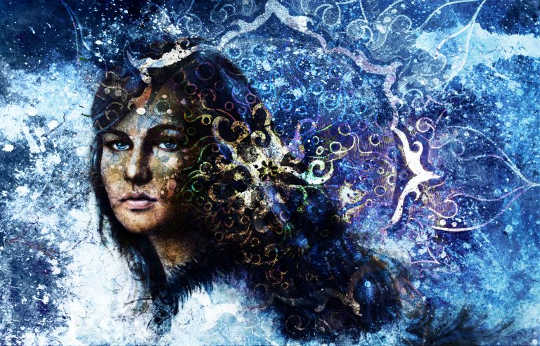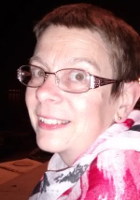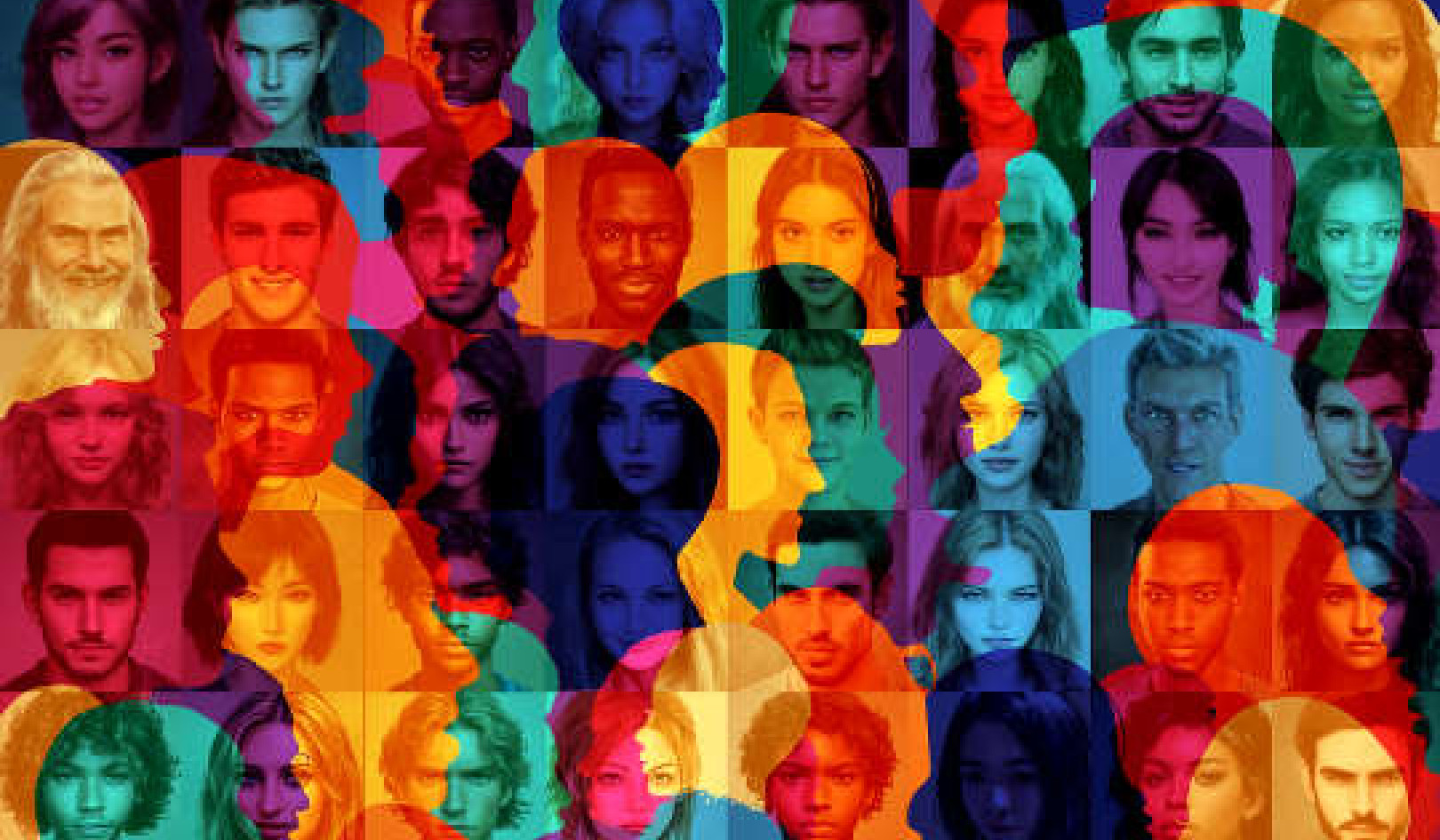
Sedna is the Inuit sea goddess, also known as mother or mistress of the sea and goddess of the underworld. There are many versions of her story, but it is basically told that upon reaching marriageable age she refuses all proposals, preferring to remain in the comfort of her parents’ home.
Finally, a mysterious and attractive stranger steals her heart, but once at their new home he reveals himself to be Raven Man and Sedna realises she’s been tricked. She is livid but remains trapped in the unwanted marriage. Her distressed cries eventually reach the ears of her father who sets out to rescue his daughter, bringing her home in his boat.
Some way into the homeward journey, Raven Man swoops down upon them, churning the water into a violent storm with his wings. Sedna’s father tries to beat him away with his oars, but the boat begins to fill with water. In an act of unthinkable cowardice, he throws his daughter overboard in an effort to save himself. As she desperately clings to the side of the boat, he cuts off first her fingers and then her hands to prevent her from capsizing his vessel. Utterly broken, she sinks to the freezing depths of the sea while her fingers and hands become the fishes and other sea life (and in some stories, land animals too) upon which the local people depend for their survival.
Sedna has lived in the darkest depths of the ocean ever since, hurt and angered by this betrayal: wrathful and resentful. When food supplies are waning, the shaman descends into Sedna’s watery underworld to coax her into releasing more sea creatures for food. Initially she withholds nourishment in retribution for the devastating betrayal she suffered at her father’s hands. The shaman must soothe and appease Sedna by paying attention to her and combing her tangled hair. Eventually her heart is softened and she releases the sea creatures to nourish the people on dry land.
As such, Sedna is the arbiter of human survival. She controls the very nourishment necessary for survival. As goddess of the underworld she also binds the souls of the dead, preventing them from completing their transition into other realms. These tortured souls remain in her dark and murky depths until such time she feels suitably inclined to release them from their purgatory. Once again, the shaman plays a role here, petitioning her to take pity on these imprisoned souls and free them. But Sedna is not easily charmed and this process can take some time!
Astrological Sedna & early life betrayals
Astrological Sedna is a distant dwarf planet sitting in the icy Oort Cloud. Her orbit is highly elliptical and takes 11,406 years to complete. She was discovered on 14th November 2003 at 6:32 a.m. in Nogales, Arizona (the time digitally logged on the first image of Sedna – thanks to Melanie Reinhart for this data).
This Sedna speaks of paternal betrayal and the sacrifice of the feminine principal (in both males and females) to protect the patriarchal powerbase. She shows where we’ve not received the protection due to us, especially in childhood, and where we may be emotionally and psychologically frozen by unresolved trauma and pain. As such, Sedna is of great importance in the charts of people who were abused in some way by a parental figure, especially a father or father figure. This abuse can take many forms, from toxic criticism (not to be confused with constructive feedback!), rejection, oppressive control, gas-lighting, psychological, sexual and physical abuse.
There is much fury in Sedna’s world and we encounter this rage where she sits in our chart. But it is held in. This fury stews and ferments inside as we struggle to first acknowledge and then express it. Sedna takes us to the darkest depths of the emotional ocean where we remain in the suspended animation of repression and suppression, disconnected from our core feelings, instincts and intuition by the sacrifice of our emotional self.
To heal Sedna’s pain we must face up to our childlike fury at a world that failed to protect us and parents, especially the father, who failed to offer us the security needed to experience the world as basically safe. Those with the Moon high in their chart – in the 9th, 10th or 11th houses – can especially benefit from exploring their natal Sedna by house position, because such a Moon often reflects an experience of being ‘cast out’ from the family at too young an age, without the sense of security and protection necessary for healthy ego development. This may be a literal ‘casting out’, in which you’re rejected by the family and in some way set adrift. Or it can be a more abstract experience, in which you feel separated from your family structure and therefore outside of the circle of trust and protection that a healthy family provides its members. The most apparently stable and secure family can feel like a vulnerable place to a child whose emotionality, for example, is not met or contained by the parents. This Moon may feel like an outsider in their family of origin, leading to a sense of being alone in the world at an excruciatingly young age. The similarities to Sedna’s plight are clear….
At a personal level Sedna demands that we uncover, process and then release these past betrayals that have wounded us so deeply. In the chart of her discovery Sedna sits at the Moon’s north node, both in Taurus and opposing the Sun in Scorpio. The north node always points us in the direction of progress and positive transformation. It shows us the qualities, behaviours and priorities most conducive to the full realisation of our potential. As such, Sedna’s positioning here invites us to face up to our personal and collective histories. To acknowledge the pain of past betrayals and the intense feelings of resentment and revenge born of them. For only in doing so, only in fully embracing what may be excruciating emotions, can we rebuild a sense of self and soul that honours the truth of who we are and how we came to be that way.
Dependency & lack of independence
Sedna was seduced by the promise of a luxurious existence offered on a plate by an apparently attractive suitor. She didn’t set out to make her own life, but instead waited in the parental fold until one came along. She paid for this choice by discovering it was all a ruse and the life she gained was worse than the one she left. Her rescue came as a happy surprise, only for her to discover that when the chips were down even her father was prepared to betray her. As she clung to the side of his boat and he cut off her fingers and hands, all hope was lost and she sunk to the floor of the ocean, achingly alone.
As such, astrological Sedna also illuminates where we’ve failed to take charge and make our own life, instead placing responsibility for our well-being and happiness in the hands of others. When considering the role of Sedna in our life, it can be useful to reflect on when and how we allow social mores to disempower us instead of proudly standing firm, declaring ourselves sovereign and free? When and where do we choose the path of fear that shrinks our life to a mere shadow of its true potential – and then blame other people for our fate? Where have we become frozen in resentment or the desire for revenge, refusing to let go of the pain inflicted by another? We may find Sedna in any such scenario, where autonomy has been sacrificed for the false security of a gravely diminished life.
The shaman sets out to appease Sedna for the sake of humanity. Just as, eventually, the only way out of resentment and betrayal is to allow our icy and broken heart to heal. The chill of the meltwaters will surely take our breath away, but in their wake we begin to see sunshine dancing on the waters above and somehow we’re not as lost in the deep as we once were. We find ourselves reaching up towards daylight rather than down into the seductive darkness. We don’t need the shaman to comb our matted hair just to feel some sense of connection. We can comb our own hair before heading out to engage with the world anew.
Sedna and the personal shadow
For all her pain, Sedna becomes an immensely powerful presence, controlling the very food that humans rely on for survival. She would never be in this position if her father had simply taken her home! Betrayal, despite its traumatic signature, nevertheless empowers us at some level. It unleashes the darkness that we can no longer ignore. We recognise in ourself a vicious harridan or a murderous stalker. We indulge in fantasies of revenge like we’ve never known before. They unsettle us and we wonder if we’ve lost our mind. But this confrontation with our own darkness is also an initiation into a more honest and authentic life. For in seeing the immensity of our shadow we also discover our innate power to take charge and rewrite our life. Conversely, our tendency to keep hidden all that shames or pains us becomes an endless feedback loop that keeps everyone in disempowered denial, for no one wants to be the first to own up!
But those dependent on mythological Sedna for food must be willing to consume her very flesh to survive. The fish in their bowl is born of her severed digits – nourishment from unimaginable pain. Like them, we too must be prepared to partake of our share of the shadowlands. We cannot live on love and light alone, but must embrace the darkness and pain which frame the radiant essence of our being. Failure to take responsibility for the personal shadow turns the collective one into an unruly behemoth that acts out in group and global acts of violence, tyranny and oppression. In Sedna’s world there is no ultimate ‘right’ and ‘wrong’, ‘good’ and ‘bad’. Her initially courageous father set out to rescue her from the intimidating Raven Man, then ends up sacrificing her to the sea. Sedna took out her betrayal on everyone, not just her father, condemning all of humanity to an endless fight for survival because she was wronged. The shaman soothes Sedna, not out of compassion for her suffering, but to manipulate her to release the much-needed food. No one comes out of this story smelling of roses! But perhaps, in our most honest moments, we can identify with every one of these positions and acknowledge that we too can be all of those things.
The truth of who we are doesn’t come neatly packaged. In a world of contradiction and paradox, few such things are straightforward! The truth of ourselves is complex and uncomfortable. It’s our contradictory nature which says one thing and does another, both equally heartfelt. It’s us as loving and rejecting in the same moment, as peaceful and angry, as wise and yet impulsive and unthinking. It is you and me as spiritual and material beings, infused with the divine whilst bound to the physical realm of form and desire.
This path bears many pitfalls. We may have to fall down them to discover what’s real and what’s not, who we are and who we’re not. Our discoveries may shake us to the core and challenge who we believe ourselves to be. But within that challenge lies the deepest truth: that when we touch the very ground of our being, all paradoxes are resolved into the simple statement ‘this is me’. No apology. No excuse. No explanation necessary.
It all boils down to this: Sedna simply doesn’t care! She’s livid and resentful, brooding day and night on betrayal, plotting her revenge. She demands to be appeased, for wrongs to be righted. You can think what you like. Judge her all you want. Empathise or not. She is what she is and she won’t be dismissed or denied. Not anymore! Sedna offers us the strength to sit in the eye of the storm that is the Self and see all things without flinching. Only then will she offer up the nourishment we so desperately need – sustenance born of betrayal.
Don’t forgive too soon!
Where Venus, goddess of love, says ‘forgive and forget’, Sedna warns us ‘don’t forgive too soon’! There’s a time and a place for remembering who did what to whom, for replaying past hurts to mine them for diamonds. Rapid forgiveness maybe little less than avoidance or spiritual bypassing, while real resentments fester beneath the surface, undermining peace of mind and our capacity to discern well in future. Life’s big betrayals need time to heal and forgiveness, like grief, is a process, not simply a decision. We must feel the hurt, rail against the injustice, even vow revenge to allow ourselves to sleep at night! For only by naming and then accepting the devastation wrought upon us can we truly come to a place of peace within – a peace hard won on the battlefield of emotional trauma.
The key is to know when it’s time to let go some more, to quieten the ranting mind, the repetitive story telling of how we’ve been wronged, the identification with the wounded self that will never trust again. We cannot abandon any of these selves immediately for they have a right to be there and much to say. By the same token we mustn’t allow them to become so comfortable that they never want to leave!
Sedna never withholds forever. She allows the shaman in and lets him comb her hair and soothe her troubled heart which eventually softens enough to unbind the dead and release the fishes for food. She knows when it’s time, despite that horrific betrayal. She knows she can’t hold on forever. And neither can we. Trauma breaks us. It tears apart a life and devastates the hapless beings trying to live it. We may feel utterly decimated by the betrayal of someone we trusted and loved, annihilated by the pain which, in the moment, feels like it will go on forever. But we can’t let it. And neither does Sedna. Eventually we begin the journey out of pain and into a new life that nourishes ourself and others.
Sedna: Goddess of our Age
Sedna trined the Saturn / Jupiter conjunction in December 2020 before establishing her presence more fully at the apex of a T square to the Sun and Moon at the Blue Moon in August 2021 and conjunct the Moon and north node at the lunar eclipse, and the north node at the solar eclipse, in November and December 2021.
Currently straddling the penultimate and final degrees of Taurus, she’s approaching her entry into Gemini which begins in June 2023. Sedna’s been in Taurus since 1965/6 during which time rampant materialism has consumed our world, at the expense of a deeper movement towards wisdom and integrity. The material world of ‘things’ has been positioned as our anchor, our safety blanket. Sedna’s father’s boat is the world of money, of fashion, of the latest smart phone, the latest game, to which many cling for dear life, seeking meaning in a world devoid of soul. In the final degree of a sign, we have the opportunity to bring about closure. To glean all the teachings available in a situation and bring it to a conclusion that sees us enrichened for the experience. As Sedna traverses these final degrees of Taurus the dark underbelly of materialism is laid bare for all to see as the billionaire elite pull the strings of the entire world, in which ever-growing numbers are plunged into poverty, while they become ever richer.
But Sedna speaks now of a shift approaching: a chance to consolidate bold new beginnings when Saturn conjuncts Neptune in the very first degree of the zodiac (0o Aries) in February 2026. This conjunction between Saturn (planet of form, duty, responsibility, oppression and self-discipline) and Neptune (planet of dissolution, unity, spirituality, compassion and deception) occurs once every 35-36 years and augurs a manifestation of popular ideals and aspirations (Neptune) into form (Saturn). The last conjunction, for example, saw the fall of the Berlin wall. Its energy empowers the people to embody changes they’ve worked hard to manifest in the previous years. It portends a groundswell of energy that cannot be diminished or deflected by an elite powerbase increasingly weakened by its own exposure.
Historically this conjunction has been associated with revolution and rebellion, some more successful and liberating than others. But with this up-coming conjunction occurring in the very first degree of the zodiac, we could see the unfurling of fresh potential unlike anything we’ve ever seen. Not only because the first degree of the zodiac is the fundamental place of a fresh new start, free of familiar hindrances, but also because a few months after this conjunction, in July 2026, Uranus in Gemini and Pluto in Aquarius form a trine which continues for two years (we’ll get a hint of it in August / September 2025 too). Imagine that: Uranus (freedom and innovation) in creative and flowing aspect to Pluto (deep transformation) in Aquarius (the sign of humanity and equality). This isn’t the challenging disruption of the Uranus / Pluto square of 2012 – 2015 (although it will further the agenda of liberating transformation unfurled then) but instead a creative and innovative energy, supportive of all who commit to the manifestation of our new world that many are already birthing into being. No more top-down tyranny! No more ‘might makes right’. This world will be built on truth and freedom, personal responsibility and collective wisdom. We sow its seeds right now with every assertion of our sovereign right to be free.
But what does this have to do with Sedna?
Well… the Sabian Symbol for the first degree of the zodiac is a woman just risen from the sea, embraced by a seal. This is an image often used to depict mythological Sedna, the Inuit sea goddess. Carvings exist of her together with a seal or as part human, part seal. Indeed, as noted by Melanie Reinhart within a week of Sedna’s discovery, the biggest seal hunt in fifty years took place. Sedna’s association with the seal is central to her mythology and, as such, she is linked integrally to this very first degree of the zodiac. But in this image we see a risen Sedna, emerging from the frozen depths in an act of choosing, finally, to release herself – and the departed souls she has previously bound – from the bitter, stagnant past and breathe once more the fresh, revitalising air of life above the waves.
But how long will she remain there before allowing the past to pull her back down? We don’t know if or when that might happen. The great astrologer Dane Rudhyar describes the seal as a regressive animal that once emerged from the sea to dwell on land before returning to its watery realms. In this we see reflected the potential for regression even as we strive to release the past and embrace new life. Every new beginning contains all potentiality, including that of resignation and failure. So nothing is set in stone. I’m not saying that come February 2026 all will be well and humanity will miraculously emerge from this time of darkness, manipulation, lies and tyranny. Nor am I saying that we must wait until then for anything positive to happen (indeed, individuals the world over are making positive things happen all the time!). I am saying this: the developmental arc of this current age sweeps towards February 2026 when Saturn and Neptune are conjunct in the first degree of Aries – Sedna’s degree. As such this arc highlights the issues that Sedna raises for us. It asks that we look within to consider our own frozen deep into which we have cast pain, trauma and betrayal, demanding that something outside of ourselves release us from pain inflicted by another. To do this we must contemplate the complexities of forgiveness and their subordination to an intransigent identification with victimhood at one end of the spectrum and a stubborn refusal to acknowledge one’s own woundedness and pain at the other.
Never give your power away!
But perhaps most importantly of all, this developmental arc towards Sedna’s degree asks us to reflect on the many ways in which we give our power away to others and how we respond when those to whom we have given our power betray us. As I commented in August 2021, since our world was openly hijacked in 2020, humanity has been Sedna: clinging to the side of the boat while the ‘experts’, the political elite, the billionaires, the global corporations & financial institutions that run the world, severed our fingers one by one. It is for each and every one of us to reflect on how we personally responded as this happened; to consider the extent to which we offered up our freedom for manufactured ‘safety’ or our independent mind for acceptance by the crowd.
And remember – what looks like power may prove to be anything but! Sedna demands much of the shaman. She will not give up the sea creatures for food until suitably appeased, and even then only for a while. At one level this looks like she holds the reins, but at another it renders her weak, for what if the shaman refuses to bend to her will? What if his people tire of being held to ransom and find another way to nourish themselves? How will Sedna receive her comfort and healing then? As such Sedna illuminates where we think we’re in charge, when in fact we’ve painted ourselves into a corner through dependence on another. Relational dynamics are complex in Sedna’s world – just as they are in ours…
When thrown by her father over the side of the boat, Sedna struggled for her very life, only to experience the ultimate betrayal when he cut off her fingers to save himself. It looked and felt like the end but eventually, from it, new life was born. Perhaps we could all benefit from contemplating that fact right now! What looks like the end isn’t the end. It can equally be the gestation of an entirely new way, impossible to imagine from this vantage point. Who knew Sedna’s severed fingers would become nourishment? Certainly not her! And certainly not her father who simply had his own survival in mind. The loss of hope and protection – of loyalty and affection – eventually became the very thing that gave Sedna her power. New life from the horror of unthinkable betrayal.
As the unrelenting march of globalist transformation continues, so too does the growth of a new world and a new way, its fledgling promises shimmering in the darkness. Will it be birthed into being? Only time will tell. And only we can make it happen. But as the Saturn / Neptune conjunction of February 2026 edges closer by the day, we can all choose to wrest back our future and ensure it works out our way!
Learn more about Sedna – including what she means in your own birth chart – from my new e book Living Astrology: Sedna & Other Astrological Avatars, from which this article was adapted
©2022. Reprinted with permission of the author.
About the Author
 Sarah Varcas is an intuitive astrologer with a passion for applying planetary messages to the ups and downs of everyday life. In doing so she aims to support people in their personal and spiritual development, making available celestial wisdom which may otherwise be inaccessible for those without astrological expertise.
Sarah Varcas is an intuitive astrologer with a passion for applying planetary messages to the ups and downs of everyday life. In doing so she aims to support people in their personal and spiritual development, making available celestial wisdom which may otherwise be inaccessible for those without astrological expertise.
Sarah has studied astrology for over thirty years alongside an eclectic spiritual path spanning Buddhism, contemplative Christianity and many other diverse teachings and practices. She also offers an online (via email) Self-Study Astrology Course.
You can find out more about Sarah and her work at www.astro-awakenings.co.uk.
books_awareness




























